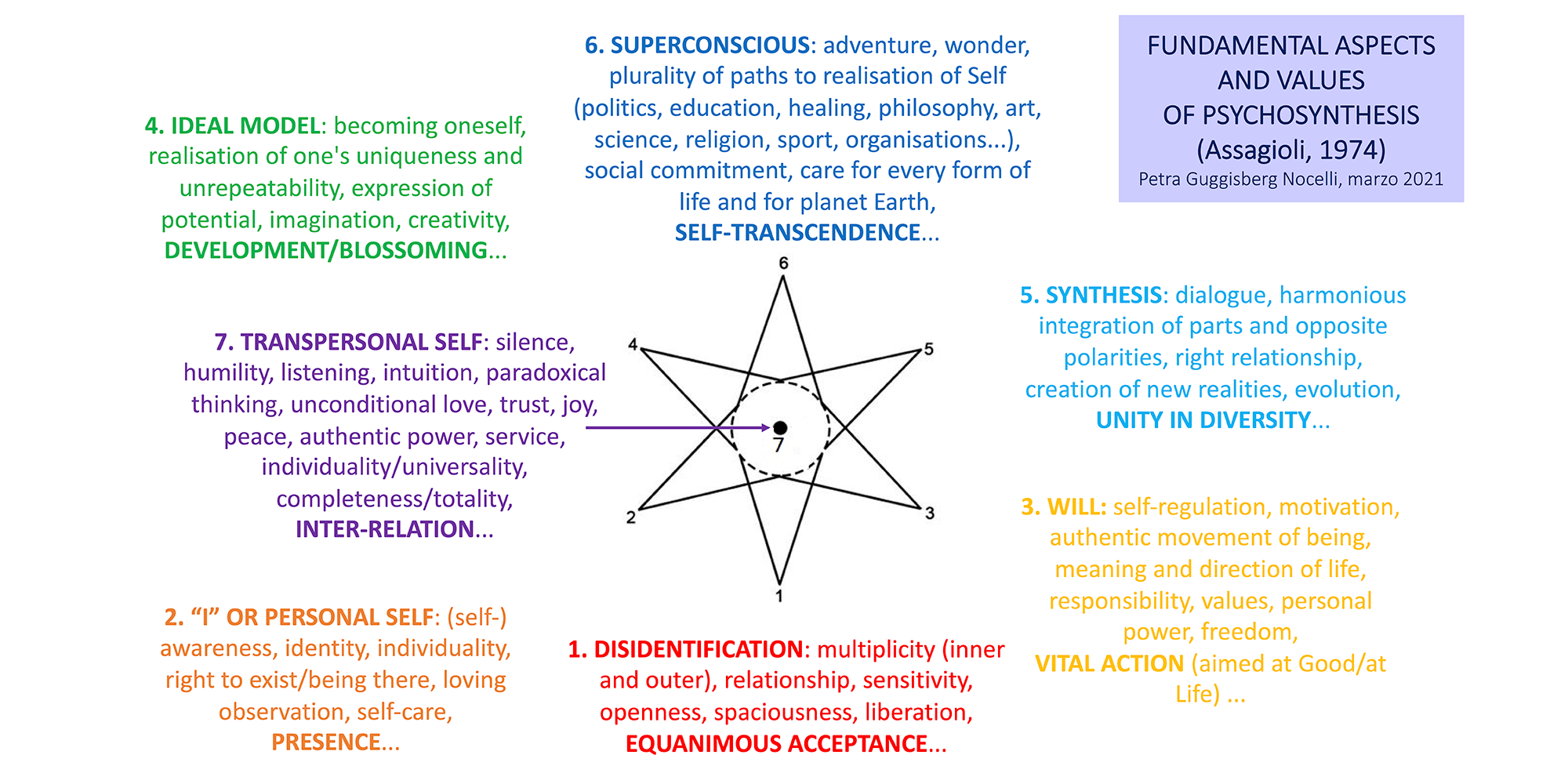
Fundamental aspects and values of psychosynthesis
I share with you an image in which I have tried to synthesize some germinal reflections on the fundamental aspects and values of Psychosynthesis (Assagioli, 1974). I hope they will be a stimulus and an invitation to explore further! You can find the full text written by Roberto Assagioli below.
These reflections were inspired by the online gathering on 8 March, organized by the EFPP in honour of the nascent EPA (European Psychosynthesis Association) a new platform for co-creating the future of Psychosynthesis.
Training – A Statement by Roberto Assagioli (19 May 1974)
Source: Website “psicoenergetica” by Vittorio Viglienghi
Link: Microsoft Word – TRAINING.doc (psicoenergetica.it)
- Undertaking training in psychosynthesis means beginning to learn about psychosynthesis and experiment with it on oneself, in order then to help others to use it on themselves. Before being able to communicate psychosynthesis to others, we must have experimented with it in depth on ourselves. Intellectual knowledge is not sufficient. Every single technique must be tried out at length on oneself. Only thus shall we be in a position to communicate it with authority.
- While psychosynthesis is offered as a synthesis of various therapies and educational approaches, it is well to keep in mind that it possesses its own original and central essence. This is so as not to present a watered-down and distorted version, or one over-coloured by the concepts and tendencies of the various contemporary schools.
Certain fundamental facts exist, and their relative conceptual elaboration, deep experience and understanding are central, and constitute the sine qua non of psychosynthetic training. These experiences are:
- Disidentification
- The personal self
- The will: good, strong, skilful
- The ideal model
- Synthesis (in its various aspects)
- The superconscious
- The transpersonal Self (it is not possible in the majority of cases to have a complete experience of this; but it is good to have some theoretical knowledge of its characteristics and the experience of its guidance).
- Different levels of meaning are associated with each of these experiences, none of which will ever be definite and complete. Continuance of one’s training, however, will always reveal new and more interesting aspects, which link the experiences together. That is to say, each experience will be seen to be not isolated, but to imply others. It is therefore unrealistic to speak in terms of “having understood or not having understood”. Understanding being ever partial, belief in having understood all indicates lack of understanding. It is a question of a gradual process.
- The preceding point clearly suggests that the best attitude to adopt – and one that is at the same time more realistic, more honest and more effective in achieving rapid progress in training – is one compounded of humility, patience and experimentation.
- Psychosynthesis is not identified with any technique or practice. Despite the fact that in group work use is often made of guided imagination and visualization exercises, psychosynthesis can by no means be levelled down to these techniques. One can know all the principal ones and still not have grasped the spirit of psychosynthesis. And vice versa. Real training entails both these factors – intuitive understanding of the spirit of psychosynthesis and a sound technical knowledge.
Psychosynthesis functions in five main fields:
– the therapeutic (psychotherapy; doctor-patient relations);
– personal integration and actualization (realization of one’s own potentialities);
– the educational (psychosynthesis by parents and by educators in school of all degrees);
– the interpersonal (marriage, couples etc.);
– the social (right social relations within groups and between groups).
Each one can choose a particular field of work and specialize in it alone. Being familiar with the other fields, however, is valuable, since all fields are interconnected. But the field of self-actualization and integration being the heart of psychosynthesis, a thorough knowledge of it is necessary for anyone operating in the other fields.
- The achievement of a certain degree of mental polarization is required for becoming a psychosynthesist. This does not mean developing the mind while repressing or ignoring the emotions. On the contrary, it means cultivating the mind and not only the emotions, as well as acquiring a personal centre of gravity within a sort of balanced and loving “reasonableness” (in the widest and deepest sense of the word) rather than an uncontrolled emotionalism.
- Training in psychosynthesis has no end. At a certain point hetero-training (meaning training guided by someone else) is replaced by self-training. Psychosynthetic self-training should never stop. Psychosynthesis is an open system: there is no end to it, but only temporary halting places.
- Only when one has acquired a thorough training (and this in the judgement of whoever is directing the training) is it wise to commence to engage in psychosynthesis professionally with individuals or groups. The time this needs is impossible to establish in advance, there being many variables involved.
- Since the training is endless, it is wise to modify both the duration and intensity of the hetero-training received: by intensity is meant the number of sessions a month.
- Since each can only be a partial expression of what we call “psychosynthesis”, it is well to gain experience of psychosynthesis through the methods and personalities of various psychosynthesists.
- Like any other form of training, training in psychosynthesis can fall away and become distorted after a certain period of time, particularly when not actively maintained and continued. Therefore it pays to undergo a refresher period now and then.
